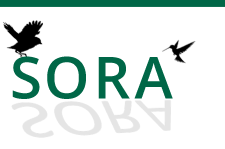Abstract
Artificial wetlands, such as aquaculture ponds, may act as surrogates of natural wetlands for some shorebirds. We found 26 nests of the Black-necked Stilt Himantopus mexicanus during weekly surveys conducted from June to July 2000 in a shrimp farm in northeastern Venezuela. All nests were located on dikes around production ponds, areas without vegetation, and 24 of the nests were in six loose clusters. Half of the nests (n=13) were built with a combination of woody material and gravel, 31% (n=8) with woody materials, and 19% (n=5) with only gravel. Mean clutch size (n=21) was 3.76 ± 0.83 eggs/nest and the most common clutch was four eggs. Our results suggest that shrimp-farming ponds in the studied area may be important artificial wetlands for the Blacknecked Stilt because these offer suitable conditions for nesting.
Creative Commons License
Recommended Citation
Rodríguez-Ferraro, Adriana and Lentino, Miguel
(2022)
"Anidación de la viuda patilarga Himantopus mexicanus en los alrededores de las lagunas artificiales de una granja camaronera en Venezuela / Nesting of the Black-Necked Stilt Himantopus mexicanus Around Artificial Ponds within a Shrimp Farm in Venezuela,"
Revista Venezolana de Ornitología: Vol. 12
:
Iss.
1
, Article 5.
Available at:
https://digitalcommons.usf.edu/rvo/vol12/iss1/5

